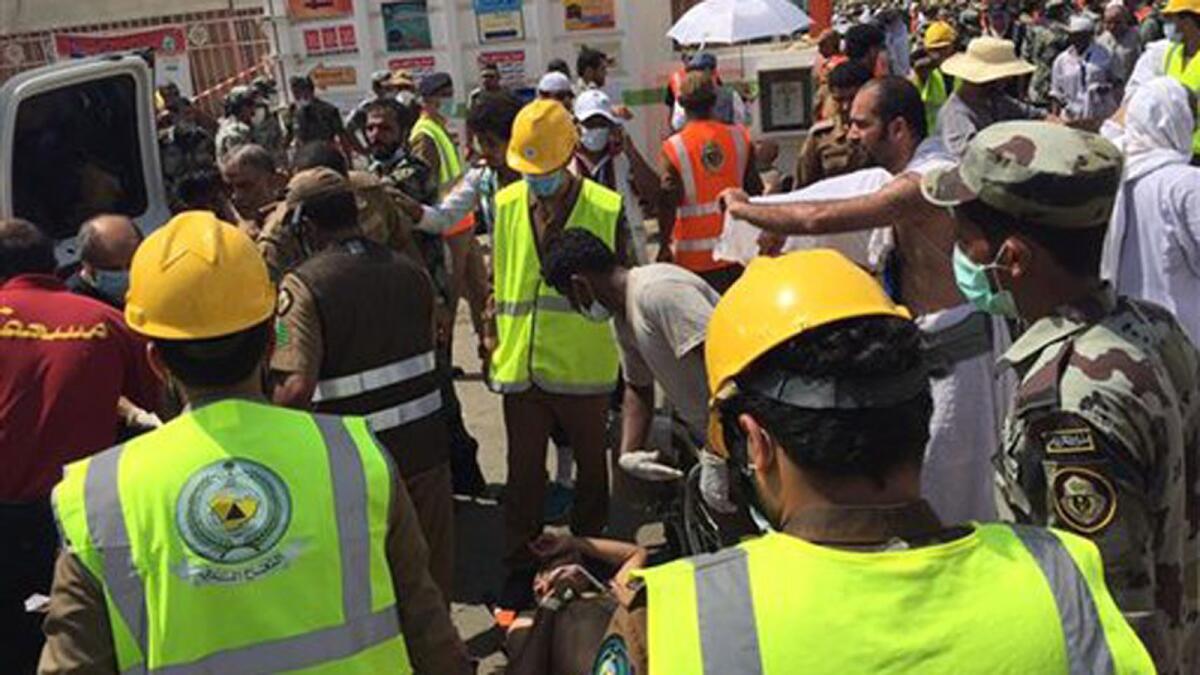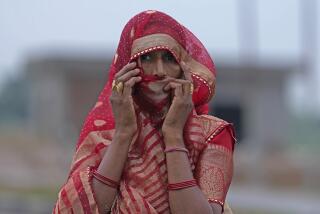Stampede at Saudi hajj kills 717, leading to question: Why again?

In an image from the Twitter feed of the Saudi civil defense, rescue crews respond to the stampede in Mina, Saudi Arabia.
- Share via
Reporting from Cairo — How could it have happened again?
Anguished relatives and stunned pilgrims demanded answers after at least 717 people were killed and 805 injured Thursday in a crushing crowd outside the holy city of Mecca, according to Saudi Arabia’s civil defense directorate.
The stampede occurred in Mina, close to Mecca, during the last major rite of the annual hajj, or pilgrimage, according to the official Saudi press agency, citing civil defense officials. Photos and video from the scene showed white-clad corpses laid out on orange stretchers — rows and rows of them.
It appeared to be the worst disaster in a generation involving the pilgrimage, which drew about 2 million Muslim faithful this year. The hajj, which began earlier this week, culminates in the Eid al-Adha, or Feast of Sacrifice, beginning Thursday.
Civil defense officials said in a statement that rescue teams totaling some 4,000 workers were treating the injured and collecting and identifying the dead. Frantic family members of those making this year’s journey flocked to social media to try to determine the fate of loved ones.
The deadly accident posed the latest leadership challenge to the relatively new Saudi monarch, King Salman, who acceded to the throne in January. Almost immediately, Salman shook up the royal line of succession and embarked on an air war against Shiite Muslim rebels in neighboring Yemen – a campaign whose effectiveness has been questioned by military experts and whose heavy civilian death toll has been denounced by human rights groups.
The cause of Thursday’s disaster was not immediately clear, but in the past, such stampedes have taken place when some of those in a tightly packed crowd begin fainting or suffocating in the crush. The ensuing panic then causes more casualties from trampling and asphyxiation.
In such large crowds, the flow of foot traffic can turn catastrophic if not correctly managed. An Egyptian survivor named Abdullah Lotfy said an oncoming wave of pilgrims suddenly found itself entangled with a throng moving in the other direction.
“I saw someone trip over someone in a wheelchair and several people tripping over him. People were climbing over one another just to breathe,” Lotfy, 44, told the Associated Press.
Thousands had gathered Thursday for the rite of “stoning the devil,” in which the faithful hurl pebbles at a wall symbolizing Satan. In 2006, more than 360 pilgrims died in a crowd crush during the ritual, and safety improvements were implemented in its wake.
But a death toll about double that of the 2006 stampede raised questions as to whether the oil-rich kingdom, which prides itself on its guardianship of Islam’s holiest sites, has adequate infrastructure and safeguards for the flood of pilgrims who make up one of the world’s largest regular migrations.
The fatalities were the worst since 1990, when more than 1,400 pilgrims died in a tunnel linking Mina and Mecca.
Like so much else that occurs in the Persian Gulf region, the fatal stampede took on overtones of sectarian rivalry. Shiite Muslim Iran suggested that Sunni-dominated Saudi Arabia bore responsibility for the deaths, including those of at least 89 Iranian pilgrims, Iran’s state news agency reported. That led to some angry online exchanges between critics and defenders of Saudi Arabia.
A spokesman for the Saudi interior ministry, Mansour Turki, told a news conference in Mina that a special panel would conduct an investigation and report its findings directly to Salman.
The pilgrimage is designated as one of the five pillars of Islam, and the devout believe that all Muslims who are physically able should perform the hajj at least once in their lives.
This year’s hajj had already been marked by one deadly accident, when a construction crane collapsed at Mecca’s Grand Mosque this month during preparations for the pilgrimage, killing 109 people.
Special correspondent Hassan reported from Cairo and Times staff writer King from Istanbul, Turkey.
ALSO:
Profound changes in China are straining its economic ties with the U.S.
European Union leaders agree on measures to alleviate migrant crisis
U.S. House chaplain, a fellow Jesuit, hopes for the rare honor of blessing the pope
More to Read
Sign up for Essential California
The most important California stories and recommendations in your inbox every morning.
You may occasionally receive promotional content from the Los Angeles Times.










